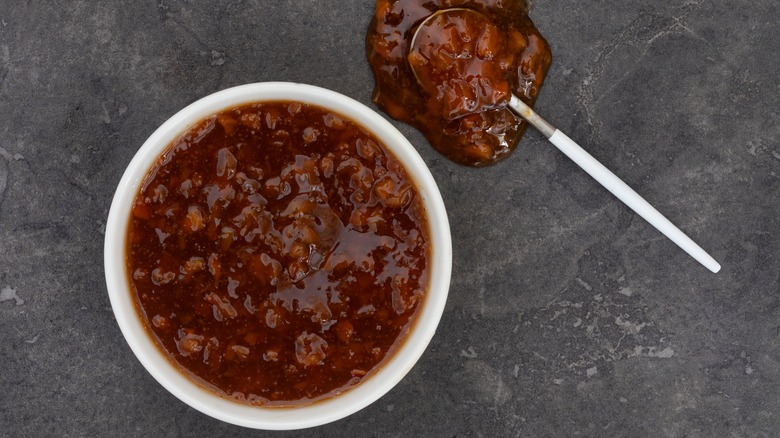HOME-MADE “MRS BALLS”
One of South Africa’s iconic dishes, Mrs Balls has gone from a popular local condiment to a world-famous brand.
While the store-bought original tastes fantastic, making your own is easy. Plus, as we all know, it always tastes better when you make it yourself!
But first – the story behind the name…
The product was created by the Ball family and still displays the family crest on the top of the label today. While its history is complicated, its popularity can be traced back to the Mother City.
The official Mrs Ball’s website claims that the recipe first belonged to an Indian chef aboard the SS Quanza. During the journey, Mrs Adkins, a keen cook, asked an Indian chef about the magical dip that he’d made one day at lunch. Keen to share his culinary secrets, the chef gave her the recipe for his special “chatni,” a Hindi word for a relish made with fruits and spices, which would later be called chutney in English.
Disaster struck on the last leg of the journey. After hitting a storm, the ship sank. Mr and Mrs Adams survived and managed to salvage the recipe. (There are arguments that this story is false and only told to dramatize the product’s history. The shipwreck actually occurred in 1872, not 1852 as the official website says).
The chutney recipe stayed in the family and was passed down to Amelia Adams, one of the daughters of Mr and Mrs Adams. She married Herbert Saddleton Ball, becoming They eventually settled in Fish Hoek where Amelia would often make the chutney for church bazaars, and her husband would sell bottles of chutney on the train to Cape Town.
Businessman Fred Metter helped the family scale up the business, chose the famous octagonal shape of the bottle, and insisted it be kept in glass instead of plastic.
Amelia passed away in 1962 at the age of 97, leaving behind a family legacy that will endure forever. The family business was sold to Brook Bond Company in the 1960s, after which it was sold to Lever Brothers who eventually sold it to Unilever SA.
In April 2013, Mrs Ball’s became a wholly-owned subsidiary of Tiger Consumer Brands Limited. It is now exported to the rest of Africa, Europe, the Middle East, New Zealand, Australia, and more.
Makes about 18 bottles (mild)
Ingredients:
612 g dried peaches (1-1/4 pound)
238 g dried apricots (a little less than 1/2 pound)
3 liters dark grape vinegar (12 cups)
2 – 1/2 kg white sugar (5 pounds)
500 g onions (1 pound)
120 g salt (5 teaspoons)
5 g cayenne pepper (2 teaspoons – it is much less dense than salt)
- To make chutney “hot”, add 75 g (1/3 cup) minced hot peppers.
- To make just peach chutney, leave out the dried apricots and use 850 g (1-3/4 pound) dried peaches.
- Soak the dried fruits overnight in the vinegar.
- Then boil (medium to low heat) in the same vinegar until soft, and drain. (Do not discard the vinegar – you will continue to cook the fruit in it.)
- Mince the fruit in a food mill or chop it up with a knife.
- Add the fruit, sugar (dissolved in a little of the same vinegar), and onions (minced) and boil in the vinegar in a large pot.
- The amount of vinegar will depend on the consistency. It should not be too runny or too thick but like the product in the bottle.
- Do not boil too long, watch the consistency.
- Add the cayenne pepper and/or hot minced pepper, and boil 2 to 2 1/2 hours (on low heat).
- Stir now and then with a wooden spoon to ensure it doesn’t burn or stick.
- When completely cool, jar in airtight bottles.

